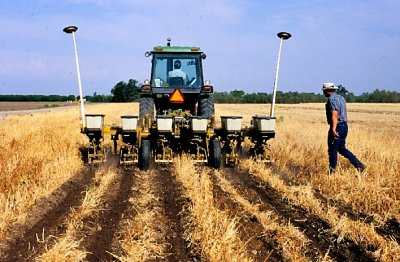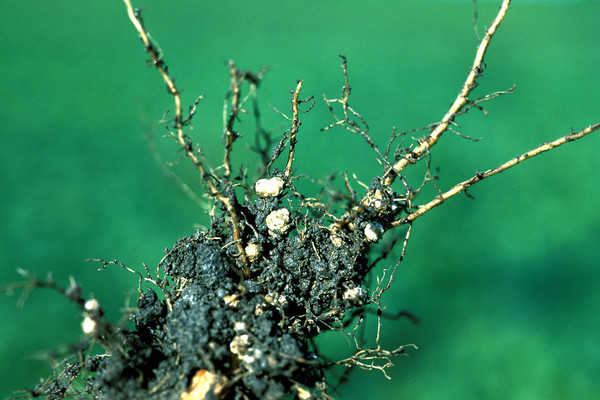Learn

Soil Sustainability
When humans use soil, they make it more prone likely or vulnerable to erosion. Using the soil for growing plants can also deplete certain soil nutrients making the soil less fertile and able to produce crops. There are several ways that humans can help reduce the negative impact that they have on soils and maintain a certain level of soil sustainability.
One of the most important steps that humans can take in order to help prevent soil erosion is to replace vegetation that was stripped from the land during use. This gives the soil protection against the effects of wind and water erosion.

Cover crops, such as winter peas, acts as a protection crop against erosion and helps provide nutrition to the soil.

Agricultural Practices
In agriculture, there are several farming and planting practices that can be used to prevent soil erosion:
- no-till planting
- minimum tillage
- terracing
- strip cropping
- contour tillage
- creating windbreaks
Plowing causes soil to be more prone to erosion. During plowing, the vegetation is removed from the soil, and the soil is broken up. In most cases, the soil is turned to a depth of 8 to 12 inches and disked several times to prepare the seedbed. These actions leave the soil vulnerable to the effects of erosion. One farming method that helps reduce the effects of plowing is no-till planting. With no-till planting, the soil is not plowed. Instead, the native vegetation is killed with a general herbicide. The seeds or plants are then planted in holes drilled through the dead vegetation.
 Another farming method that helps is minimum tillage. An example of minimum tillage is ridge till, pictured in the image to the left. With this method, rows are planted with 4-6 inches of native vegetaion left between each row. This helps reduce the amount of soil that is disturbed by planting.
Another farming method that helps is minimum tillage. An example of minimum tillage is ridge till, pictured in the image to the left. With this method, rows are planted with 4-6 inches of native vegetaion left between each row. This helps reduce the amount of soil that is disturbed by planting.
Terracing is another planting method that helps prevent and reduce soil erosion. This method involves creating "steps" or flat areas on the sides of hills or mountains. Terracing reduces the steepness of the slope and the length of the slope and prevents or reduces soil erosion when planting in hilly areas. View Terrace Farming: A Unique Agricultural Solution to see images of terracing.
Strip cropping is another farming method that can be used to help prevent soil erosion. This method alternates planting rows of row crops like corn with forage crops like alfalfa. This method helps reduce the amount of exposed soil between rows. Strip cropping involves minimal extra costs and can reduce soil erosion by as much as 75%.
 Contour tillage is another planting method that helps prevent erosion. In contour tillage, crops are planted and cultivated in rows parallel to the natural contour of the land. Contour tillage can look similar to terracing, except the levels are not built up or supported by structures such as stone or wood. Contour tillage is often used in combination with strip cropping and is called contour strip-cropping.
Contour tillage is another planting method that helps prevent erosion. In contour tillage, crops are planted and cultivated in rows parallel to the natural contour of the land. Contour tillage can look similar to terracing, except the levels are not built up or supported by structures such as stone or wood. Contour tillage is often used in combination with strip cropping and is called contour strip-cropping.
A final farming method that can help reduce soil erosion from wind is planting windbreaks. Windbreaks are rows of trees or shrubs that are planted around a crop field to help protect it from the effects of soil erosion by wind. These structures help keep the wind off of the area as well as reduce the loss of soil moisture. Soil moisture is important because it binds the soil particles together making them less susceptible to wind erosion.

Fertility & Nutrients
Over time, crops can deplete the soil's nutrients. This in turn will reduce the soil's fertility. Different crops deplete the soil of different nutrients. Because of this, farmers often use a method called crop rotation to help conserve and maintain the nutrient levels and fertility of soil. Crop rotation involves a pre-planned sequence of crops grown on a particular field. For example, a farmer might plant a field of corn one year, followed by soybeans the second year, wheat the third year, alfalfa the fourth year, and then back to corn the fifth year.
The main nutrients that are depleted by crops are nitrogen compounds. Cover crops are often included in the crop rotation to help replenish those nutrients. Cover crops also help with soil erosion and disease control. Cover crops are not usually cash crops crops sold for profit . One group of cover crops that is frequently used to replace nitrogen compounds is legumes. Legumes are plants like alfalfa, lentils, soybeans, and peanuts.
 Legumes help make nitrogen compounds available in the soil for plants. Atmospheric nitrogen is not available for most plants to use because its bonds are so strong and cannot be broken apart for use. However, legumes have the ability to convert atmospheric nitrogen into organic compounds - nitrates and nitrites - that can be used by other plants.
Legumes help make nitrogen compounds available in the soil for plants. Atmospheric nitrogen is not available for most plants to use because its bonds are so strong and cannot be broken apart for use. However, legumes have the ability to convert atmospheric nitrogen into organic compounds - nitrates and nitrites - that can be used by other plants.
The process of plants converting atmospheric nitrogen into organic compounds that can be used by plants is called nitrogen fixation. Bacteria in the nodules on the roots of legumes take atmospheric nitrogen and convert it into nitrates and nitrites. In the image, soybean roots are covered with bacteria. It is a symbiotic relationship, where the bacteria provides nitrogen to the plant in return for carbon.
Decomposition of dead organisms and dead animal waste material can also help supply organic nitrogen compounds to the soil. Nitrogen is important to living organisms because it is the building block of all life forms. Nitrogen atoms are major parts of amino acids, proteins, and nucleotides that make up DNA and RNA.
Image citation:
Soybean root nodules: close view Paul Fuqua, 2004. Image. Discovery Education.
Web. 29 June 2015. <http://www.discoveryeducation.com/>.
Review the practice activity below.
Open the practice activity in a new window| Practice activity text version
Note: The presentation may take a moment to load.
 |
 |